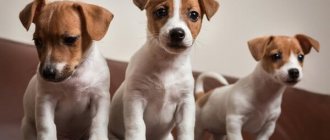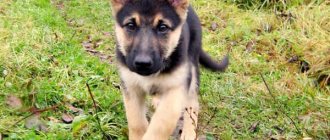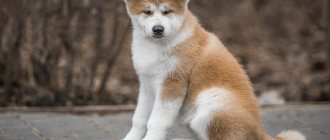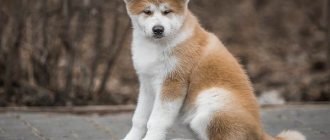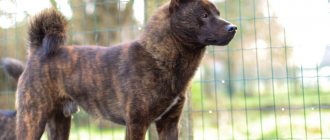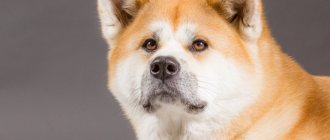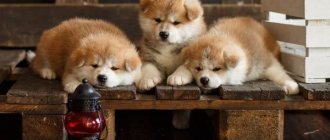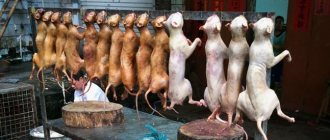The breed to which the pet belongs determines not only its appearance and character, but also its needs regarding nutrition, living conditions and care.
It should be noted that caring for a pet is not at all difficult.
A loving, caring owner will make every effort to provide his four-legged friend with everything he needs and maintain his good health.
Speaking about the Akita Inu, it is worth noting that care, which, in the opinion of many, seems labor-intensive, is in fact enviably simple.
Are they difficult to care for?
Caring for an Akita Inu is not difficult . Unpretentious by nature, dogs are not prone to whims in nutrition and eat both natural products and industrial food equally well.
Coat care does not require mandatory haircuts or trimming and is limited to regular combing and occasional washing.
Long active walks are what Akita Inu really needs . It is important to allow your pet to waste its energy; this has a positive effect on its development and health.
You don’t have to come up with complex, original games; the dog will be happy to simply bring the owner a ball or a found stick.
Description of the character of Akita Inu
Akita Inu is a Spitz-type dog. Like all representatives of these breeds, she is strong, courageous and temperamental. Her ancestors hunted large animals and protected the house from bandits. This has affected the character of modern pets. They have the following qualities:
- equilibrium;
- temperament;
- curiosity;
- good nature;
- restraint;
- independence;
- courage;
- endurance;
- patience;
- love of freedom.
The main feature of the Akita is loyalty and devotion to the owner. She always wants to be close to him, and it’s hard for her to experience separation. It’s not for nothing that Hachiko was made a symbol of this quality. Dogs remain faithful in any conditions and are ready to protect their owner, regardless of pain, hunger or other inconveniences. Akitas have a good memory. They remember everything: tone of voice, words, insults.
These pets are touchy and vulnerable. They do not tolerate criticism or raising their voice; a serious punishment for the dog is the cessation of communication. But despite this, the dog is not capable of dirty tricks, will not take revenge or misbehave at home, and is not prone to aggression. But these menacing-looking dogs are affectionate and gentle with family members. They are very emotional, although they may not show emotions outwardly, controlling them. They are able to feel a person’s mood and support him in difficult times, listen, and share joy. Dogs' independence and intelligence are often mistaken for cunning and stubbornness. But if you find a common language with your pet, such behavior will not cause inconvenience.
Attitude towards children
Akita loves children very much, protects them, and monitors their safety. It’s not for nothing that in Japan, representatives of the breed are used as nannies. The pet will constantly try to spend time with the child and play. Photos illustrate the peculiarities of communication between these dogs and people:
Photo of Akita Inu with a child
Service qualities
Akita Inu is the second most popular dog breed used in canistherapy. They can work in hospitals and rehabilitation centers. They help sick people recover and have a beneficial effect on children with mental disorders. This is due to the fact that these dogs are empaths, calm and balanced. This dog is a wonderful guard. Treats all strangers with reserve and distrust. May show antipathy. But he rarely raises his voice, even when guarding a house. Akita would rather detain the intruder until the owner arrives than bark at him. Representatives of this breed can also be used for hunting and in search and rescue services.
Education and training
Despite many advantages, this dog is very difficult to train. Akita obeys only a person with leadership qualities. If he was unable to gain authority, the dog will strive to dominate. It chooses one owner, perceives the rest of the family as companions and communicates with them as equals. In training, it is important to be firm and persistent, but you need to treat the dog with respect. Physical punishment should not be used; the pet should not be afraid of the owner.
It is better to conduct training in a playful way, and be sure to reward for success. You need to know that Akitas are very smart and quickly remember commands. It’s worth being patient and understanding when to stop what you’re doing and move on to playing. Proper motivation and a variety of impressions are important for this dog. Undesirable behavior must be stopped immediately.
You should not allow your pet to sleep on the bed or protect its toys or food from its owner. From childhood, you need to learn to react adequately to neighbors, street noise, and cars. If you start training and socializing your pet on time, there will be no problems with its behavior. This should be done from the very birth of the puppy.
An important period is from 4 to 8 months, during which time the dog chooses its owner. Education lasts up to 2 years, after which it will be almost impossible to change anything in the behavior and character of the pet. With the right approach, you can teach an Akita to perform acrobatic tricks, agility, freestyle, use it for hunting or playing sports together. Interesting video about raising an Akita:
Video: Akita Inu - features of maintenance and upbringing, reviews of owners, attitude towards children and strangers
How to care for a puppy
The first thing you need to do is show the puppy his personal place, which should already be arranged . If it’s warm outside and you plan to keep your pet in an enclosure, you can immediately place the puppy in it, otherwise you need to show him a place in the house.
CAREFULLY!
You cannot change the puppy's diet for several weeks - he should eat the same food as the breeder gave him.
Puppies should not carry heavy objects or run a lot until about 1.5 years of age, when their joints are stronger.
Hygienic care includes regular combing of the coat, trimming of nails, cleaning of teeth and ears..
It is necessary to accustom the puppy to these procedures from an early age.
An adult dog
You should follow the vaccination schedule, promptly treat for internal and external parasites, feed your pet a balanced diet - all these factors affect the pet’s health and its life expectancy.
In general, caring for an Akita Inu is almost identical to caring for other breeds and consists of brushing the coat, brushing teeth and ears, and trimming nails..
Adult Akitas are still energetic and active and need regular long walks. Perhaps this is one of the key conditions for proper and caring care for a pet of this breed.
Breed traits
Breed traits (on a 5-point scale)
| Akita Inu | |||
| Activity | in the house | 2 | |
| on the street | 3.4 | ||
| Obedience | training | 3.1 | |
| strangers | 4.4 | ||
| Domination | in family | 2.7 | |
| over dogs | 4.7 | ||
| Defending your territory | from people | 3.4 | |
| from dogs | 4.6 | ||
| Sociability | in family | 4.6 | |
| with strangers | 2.4 | ||
| with dogs | 1.7 | ||
| Concentration | in family | 1.6 | |
| in front of strangers | 3.6 | ||
| with dogs | 3.8 | ||
| Aggressiveness | in family | 1.3 | |
| to strangers | 2.7 | ||
| to the dogs | 3.9 | ||
| to cats | 4 | ||
| Family behavior | calmness | 3.9 | |
| demand for affection | 3.9 | ||
| excitability | 3.3 | ||
| playfulness | 3.5 | ||
| excessive barking | 1.5 | ||
| behavioral breakdowns | 1.8 | ||
| Tolerance for children | up to 4 years | 3.3 | |
| over 4 years old | 3.2 | ||
| Institutional use | watchman | 4.4 | |
| bodyguard | 3.6 | ||
This breed is often compared to the following dog breeds: German Shepherd, Samoyed, Alaskan Malamute, Shiba Inu, Labrador Retriever.
Give me a paw friend
Vaccination schedule
| Age | Vaccine option |
| 8-9 weeks | Nobivac DHPPI + Nobivac L Eurican DHPPI + Eurican Duramune Max5-CvK/4L |
| 12 weeks | Nobivac DHPPI + Nobivac L+R Eurican DHPPI + Eurican L+R Duramune Max5-CvK/4L(+ after 21 days Nobivac R) |
| At 1 year and annually thereafter | Nobivac DHPPI + Nobivac L+R Eurican DHPPI + Eurican L+R Duramune Max5-CvK/4L (+ after 21 days Nobivac R) |
You cannot vaccinate an unhealthy puppy, and 10 days before vaccination it is necessary to carry out deworming.
Expert opinion
Kozhevin Semyon Kirillovich
Expert dog handler.
Akita Inus are suitable for active people who have free time, as they need long, active walks. It is also necessary to feed these dogs correctly, taking into account the characteristics of their body and health. These are the 2 main components of proper care that allows you to raise a strong, healthy dog. Grooming also includes brushing the fur, trimming the nails, and cleaning the teeth and ears.
General characteristics of the Akita Inu breed
The Akita Inu is a cute, fluffy dog. It belongs to the Spitz-type breeds with developed service qualities. Height is slightly above average, hardy, active, strong. Used as a hunter, watchman, security guard, friend or nanny for children. This is one of the 14 most ancient breeds that have survived almost unchanged. Distinctive features are a triangular head, erect ears, a ringed tail and thick fluffy fur.
You can also recognize an Akita by its smiling face. This expression is obtained due to the specific structure of the mouth. Representatives of the Akita Inu breed also have special character traits inherited from their ancestors. They are smart, independent, self-reliant, loyal, and do not tolerate neglect. They can be headstrong and stubborn, so they are only suitable for an experienced owner.
| Options | Characteristic |
| country of origin | Japan |
| group of breeds according to the ICF classification | Spitz |
| life expectancy | 10-13 years |
| height | 58-65 cm |
| weight | female 23-35 kg, male up to 44 kg |
| service qualities | watchman, bodyguard, companion |
| activity | high |
| attitude towards a person | loyal, family friendly, can be aggressive |
| training | complex |
| health | good |
| care | easy, but sheds a lot |
pros
Akita is considered one of the most beautiful, intelligent and loyal pets. Despite the high cost, they have many fans. These dogs are popular because of their many benefits.
- Akita Inu live quietly both in a private house and in a city apartment. You can keep it in the yard, just don’t put it on a chain.
- These are dogs with an attractive appearance. They have a proportional build and a triangular muzzle. The peculiarity of the breed is the special structure of the jaw. Therefore, it seems that the dog is constantly smiling.
- These animals are very clean. On the street they will not get into the mud or roll around in the dust. They love to swim and have no dog smell.
- Akita Inu are very smart dogs. They are easy to learn and understand what is required of them. They easily let the owner know what they want.
- Very calm, do not like to impose themselves. They are independent and tolerate loneliness well.
- Security qualities are inherent at the genetic level. Akitas do not need to be trained to guard the house. They instinctively protect the owner, his family members, and property.
- He won't make a fuss without a good reason. They rarely bark or howl, but usually growl or snort.
- Thanks to its thick undercoat, the Akita easily tolerates cold and heat. She has good thermoregulation.
Minuses
Representatives of the breed are not without shortcomings. This seemingly cute fluffy dog is actually a strong and independent animal. To avoid problems, you need to study the disadvantages of keeping such a pet.
- This dog should be owned by a person with a strong character, self-confident and balanced. If the owner cannot gain authority, she will begin to dominate. She will not obey and will become uncontrollable.
- They do not get along well with other dogs, especially of the same sex, and can get into fights. To avoid this, you need to properly socialize.
- Very active, need high physical activity. You need to walk with your pet for a long time, run, play.
- They shed heavily. The coat needs to be brushed regularly.
- Eating problems may occur. It is difficult to choose dry food, and an allergic reaction often occurs.
- They are uncommunicative and not sociable. Without good socialization they can be aggressive towards strangers.
The video will help you learn more about the advantages and disadvantages of this breed:
Video: Akita Inu - features of the breed
Over the millennia of Akita Inu's existence, many interesting facts about it have accumulated.
- This is one of the ancient breeds, preserved almost unchanged and without impurities. Despite the fact that it almost disappeared in the 20th century, it was possible to restore the unique breed characteristics.
- Until the 17th century, Japan had the death penalty for killing an Akita. And people who hurt these dogs were sent to prison.
- The Japanese consider the Akita to be the country's treasure. This dog is a symbol of devotion, prosperity, and family happiness.
- It ranks 14th in the breed popularity ranking. This is explained not only by the character qualities of the Akita Inu, but also by its attractive appearance.
- Akita is sensitive to violation of personal space. She accepts affection only when she wants it.
- Akita Inus reach standard size by the age of 2 years. They grow and mature slowly; a dog is fully developed by the age of 3.
- Before World War II, representatives of the breed lived a long time - up to 14-15 years. After the bombing of Hiroshima, due to radiation, life expectancy became no more than 12 years.
- In 2012, a puppy of this breed was presented to the President of Russia.
History of Hachiko
The popularity of the Akita Inu breed is largely explained by the history of the dog Hachiko. It was the film about this devoted dog that made her famous in Russia and throughout the world. The Akita Inu dog accompanied his owner to the station every day and met him in the evening. But somehow the owner did not return from work; he died of a stroke. The faithful dog continued to come to the station. He waited for his beloved owner for 9 years until he died of heart disease. In Japan, everyone knew this devoted dog, and mourning was declared for him. After this, the breed was made a symbol of fidelity, and a monument was erected to Hachiko at Shibua station. A film was made about him in Japan in 1987 and a remake in 2009 in America. Pictures from the popular film “Hachiko: The Most Faithful Friend”:
Photo of Akita Inu from the movie “Hachiko: The Most Faithful Friend”
Photo of Akita Inu from the movie “Hachiko: The Most Faithful Friend”
Photo of Akita Inu from the movie “Hachiko: The Most Faithful Friend”
What you need to prepare
You should purchase products in advance to help ensure proper care for your dog.:
- wide-toothed comb;
- slicker;
- massage comb or brush with natural bristles;
- toothpaste;
- collar and leash;
- nail clipper;
- 2 bowls on a stand;
- toys;
- veined bone;
- a bed, bedding or rug;
- muzzle;
- feed;
- shampoo and conditioner;
- disposable hygiene diapers.
Cotton swabs, napkins, and towels for washing your pet can always come in handy.
First days at home
Finding itself in an unfamiliar environment, the puppy experiences stress, so it is important to ensure a calm, quiet environment in the house: you should not invite guests, play music loudly, if there are children, you should not allow them to grab the puppy.
The dog needs time to adapt and also to get used to its name.
The puppy is scared and may whine and ask to be held. You can soothe him in your arms, but you should not carry him constantly, otherwise he will never become independent.
At night, the pet may ask to go to bed with its owner, believing that this is the only safe place.
If you do not plan to allow an adult dog to sleep in the owner's bed, you should not allow the puppy to do so either . It is better to place his bed near the bed and touch the puppy when he whines.
To quickly adapt, you should not leave the puppy in the house alone, but if this is necessary, you need to limit its space by locking it in the smallest room and leaving it with toys.
Education, training
Every Akita Inu, like any dog, must be well trained or at least have basic education. This will prevent many unpleasant moments in your communication with this breed.
Training an Akita Inu is not an easy task. It must be carried out either by a very experienced owner or by a specially trained specialist. The education of this breed should begin in childhood, since this breed is distinguished by a dominant, wayward character, which is fixed in the animal in adulthood. Owners with little experience in keeping dogs can quickly “lose” to this breed in the battle of characters; as a result, the animal will decide for itself whether to obey it or not, thereby becoming the leader in the relationship between man and dog.
Akita puppies from a very young age understand what their owner wants from them, but do not always obey his will. We must pay tribute to this breed: Akita Inu are distinguished by intelligence, intelligibility, and the ability to analyze and remember what is happening.
Where to start raising an Akita Inu? The first is toilet training the puppy. As children, it is not difficult to wean them from gnawing things, to stop biting their owner during play, or to pick up food from the floor. From the very beginning it is better to show who is boss. It is recommended to immediately show the dog its sleeping place and not let it sleep in the bed. It is better to close the door to the bedroom altogether.
If you are the proud owner of an Akita Inu, training your dog should be patient and persistent. It is important to see everything through to the end. Misdeeds cannot be punished with aggression or shouting - only with a menacing look or a calm reprimand. Dogs of this breed have an incredibly good memory, as well as such qualities as vindictiveness and resentment. The person who caused her physical harm will forever be remembered by her as an enemy, against whom the animal will take revenge.
Dogs of this breed do not like monotonous repetition of the same exercises. It is recommended to alternate education with play and physical activity. However, it must be remembered that during puppyhood, Akitas still continue to form bones and joints, so until 18 weeks of age, it is better to avoid physical activity or do it only minimally.
General recommendations for raising an Akita Inu:
- Akita Inu training problems are easier to prevent than to deal with the consequences. Start training your dog from the first days it comes into your home.
- Without a specific activity or frequent games, the Akita begins to get bored. Therefore, take your dog with you for walks and jogs.
- In their area, dogs of this breed feel like masters, so there are frequent cases of attacks on uninvited guests.
- It is very difficult to resist pampering your little companion with something tasty from the table. The dog can take a very long time to achieve what it wants, jumping at the table, looking into your eyes with a pleading look, repeating this even when you take the animal to another room or order it to stop. Don’t be fooled: such indulgence can develop a hysterical type of behavior in the dog, in which it will listen to you less and less, and increasingly achieve what it wants, showing aggression, resentment and other manipulation.
Personal place
If an Akita Inu lives in a house or apartment, it is necessary to create a place for it in the corner of a closed room, where the dog can sleep or simply relax and hide from the attention of prying eyes.
You need to put there a moderately hard but cozy special bed (blanket or rug), the size of which will allow the dog to stretch out freely during sleep and generally feel comfortable.
Tips for choosing a puppy
To purchase a purebred Akita Inu puppy, it is better to go to a club or professional breeders. When choosing a baby, pay attention to the fact that it comes from a small litter. Be sure to check out the dog's pedigree. Find out what awards the puppy's parents received. It would not be the best option if they are closely related. Then the puppy may develop many genetic diseases.
Pay attention to whether the puppy eats well. He should be playful, curious and active. The dog should not be afraid of a hand extended to it. It’s good when a dog comes up with interest and sniffs you.
Feeding and diet
Akita Inu dogs are unpretentious in food, which allows them to be fed with natural products, ready-made industrial food, and even a mixed diet..
However, we should not forget about the likelihood of developing an allergic reaction or food intolerance, as well as the balance of dietary supplements and vitamins and minerals, so the choice of nutrition should be approached responsibly.
A natural diet should include:
- dairy products;
- lean meat;
- boiled offal;
- eggs;
- millet, rice, buckwheat;
- vegetables;
- fruits (after 4 months).
The serving size is calculated based on the pet’s weight: 400-500 g of food for every 30 kg of weight. Natural nutrition involves additional intake of vitamins and minerals - this helps to avoid joint problems in your pet, as well as improve the quality of the coat.
IMPORTANT!
It is necessary to control the amount of protein food, because Excess proteins lead to the development of allergies, characterized by dermatitis and digestive disorders.
In the case of feeding industrial feed, preference should be given only to high-quality products of at least premium class, and better yet, super premium class, since they are made from the most natural ingredients and contain a vitamin and mineral complex.
The number of feedings per day depends on the age of the dog:
- up to 2 months - 5-6 times;
- 2 months - 5 times;
- 3 months - 4 times;
- 4 months - 3 times;
- After six months, you should gradually accustom the dog to feeding twice a day.
In case of low physical activity and light loads, the Akita Inu can eat once every 2 days.
Origin, history
Akita Inu is a breed that appeared as a result of crossing mastiffs and Chinese Spitz breeds. This is one of the hypotheses about the origin of the Akita Inu. It is known that even in ancient times, his ancestors went with their owners to hunt large animals, even bears. The ancestors of the Aktita Inu were called Matagi Ken, and they were bred to hunt deer, wild boar and even black bears of the Akita province, which weighed up to 400 kg. History shows that they are one of the oldest breeds, including 13 other breeds: Afghan Hound, Pekingese, Siberian Husky and others. The evidence for this theory is as follows:
- archaeological excavations: the remains of similar dogs belong to 2 thousand years BC;
- results of genetic studies. They indicate that the genotype of dogs, which are representatives of the most ancient breeds, has the least differences with the genotype of the wild wolf, the ancestor of all dogs.
Gradually, the status of the Akita Inu changed. From security dogs, they turned into elite animals that could only be kept in palaces and houses of high-ranking officials. In the 18th century, Akita Inu began to serve as guard dogs for palaces. Hunting dogs turned into pets, the keeping of which was available only to the elite of society. Ordinary people, peasants could not even dream of becoming the owners of these dogs.
Interesting! The history of Akita Inu is also notable for the fact that one of the Japanese shoguns (the fifth), the governor of Akita Prefecture, issued a decree according to which whoever killed a dog was subject to the death penalty.
But there were tragic moments in the history of Akita Inu. At the beginning of the 19th century, the Akita was crossed with the Tosa Inu, a Japanese fighting dog. This happened in favor of dog fighting, popular during this period. The result of this crossbreeding was aggressive, large dogs. Gradually, the existence of the traditional Akita Inu breed came under threat. And after the rabies epidemic that occurred in Japan a little later, the number of Akitas was reduced to a minimum. But at the beginning of the 20th century, a society organized to preserve the breed achieved its resuscitation.
In modern Japan, the Akita is one of the national treasures. Monuments are erected in her honor, and her images can be found everywhere in public places.
The breed came to Europe and America after World War II. Europeans began to develop their own variety on the basis of the Akita - a large Japanese dog. Now it's a separate breed
How often should you go for walks?
You need to walk your Akita Inu at least 2 times a day for 2 hours. At the same time, it is still better if there are more walks and they last longer.
Walking is required not only for domestic dogs, but also for dogs living on the street..
Regular walks, physical activity, active games, training and communication with the owner and other animals (provided the pet does not have zoo aggression) have a positive effect on the health and development of the dog.
Features of character and behavior
The Japanese would not be able to appreciate this dog if it did not suit them in character and behavior. Akita, like a real samurai, has a reserved character, behaves with dignity, is reasonable and intelligent. But behind the calm restraint hides kindness, sincere joy and a hot temperament. Akita Inu is a worthy example of canine devotion and fidelity. You need to love a dog and then it will reciprocate.
Advantages
The advantages of the Akita include its devotion, restraint, intelligence, and curiosity. Akita is capable of selflessly standing up for its owner and coming to the aid of its relatives, despite the degree of danger, sometimes risking its life.
Flaws
The breed's minor disadvantages include the dog's rather late maturation, which requires more careful and lengthy training. Teenage curiosity and childish fun can sometimes be excessive. Impatient or rude owners may experience the dog's pride and insubordination, as the dog does not like strong pressure and tends to dominate.
Can he live on the street?
Thanks to the structure of the coat and thick, dense undercoat, Akita Inu tolerate cold well and can live outside even in winter, provided several requirements are met.:
- the enclosure should be insulated and located in a place that is not too accessible, but provides sufficient visibility;
- There should be a warm layer of blankets or straw inside the enclosure;
- It is necessary to provide your pet with warm food and water.
You cannot put an Akita Inu on a chain - this is associated in the dog with a loss of freedom and has a negative impact on its mental and physical state.
Diseases
Despite excellent physical characteristics, some dogs, although rarely, are susceptible to diseases, among which are hereditary and acquired.
- One of the genetic ailments is joint dysplasia, which can severely affect the hip joint, leading to immobilization of the animal. The insidiousness of the disease is that only a veterinarian can detect its mild degree, and when obvious symptoms appear, the dog’s movements already become impaired.
- Other Akita Inu diseases are associated with the eyes: entropy (when the lower eyelid turns inward), which can only be treated with surgery, cataracts, glaucoma, retinal atrophy.
- The result of improper care and nutrition can be gastric volvulus, so it is important to monitor whether the dog has enough physical activity and not let it overeat.
Diaper training
If your dog lives in an apartment and you need to teach it to relieve itself in a diaper, you should:
- take your pet to the diaper immediately after he wakes up or eats;
- at first, keep the puppy in a limited area, where several diapers will be spread on the floor - this leaves the dog practically no alternative and helps to quickly remember where the toilet is;
- if it is impossible to briefly limit the dog’s movements, then you should spread the diapers in several places: near the door, balcony, under the window and in places that the dog has chosen itself, gradually reducing their number.
You can also use special sprays by spraying them on diapers - they emit a specific smell that indicates to the dog that this is a toilet.
You need to accustom your puppy to a diaper from the first days in a new home..
Who is this breed suitable for?
As soon as a film about the legendary dog Hachiko, who was of the Akita Inu breed, appeared on the screens, the popularity of these dogs increased sharply. But not everything that people saw on the screen turned out to be reality. Few people were ready for the “live” Akita and its character traits.
Akita Inu will not “look into your mouth” and catch the owner’s mood. Rather, this dog will prefer that you consider its feelings and desires. This independent breed is definitely not suitable for a novice owner. Training her, although interesting, is quite difficult.
If you have a soft character and you cannot refuse a dog, then it will get the better of you and will be the main one in the family. This breed is very easy to spoil. As a result, you will end up with an uncontrollable animal that will not be to blame for this at all.
Unfortunately, many owners who did not realize that they would face such difficulties in raising them abandon their dogs. Therefore, there are more and more purebred and expensive dogs in shelters, to which the owners have not found an approach.
Long walks and exercise are important for Akita Inu. Therefore, the breed is not suitable for those who cannot devote time to this. The dog feels good in the apartment. But you will have to walk with her for at least several hours a day. Otherwise, excess energy will be splashed out on your furniture, shoes and other personal items. A big plus for keeping an Akita Inu in an apartment is that the animal does not bark without a reason. In general, this breed prefers a wide variety of sounds to barking, including grunting.
Akita Inu does not get along well with other dogs unless they were raised with her. Dogs of this breed will also be partial to small animals and cats. But they always find a common language with children. Therefore, the Akita Inu is suitable for a family with children. Provided that one of the parents will be involved in her upbringing.
How to trim claws correctly and when?
Too long nails do not allow the dog to position his paws correctly, which causes the load on the ligaments and joints to be distributed incorrectly, so the nails must be trimmed regularly.
This should be done monthly using a nail clipper designed for large dogs . After trimming, the sharp edges need to be filed with a file so that the claws do not peel off.
The claws must be shortened carefully, without touching the blood vessels or causing pain to the pet, to such a length that the dog does not “clack” on the floor when walking.
How to clean your ears
Akita Inu have open ears, in which dirt, dust and excess wax accumulate. This problem is especially relevant for street dogs.
It is necessary to clean your pet’s ears 1-2 times a week with a cotton pad soaked in a special lotion..
Healthy ears should not have an unpleasant odor, and they should have a pink tint.
How to choose a dog
You can buy an Akita Inu dog from breeders or in a kennel. This breed is quite common in Russia and there will be no problems with its acquisition.
When choosing a puppy, you need to pay attention not only to its appearance, but also to its behavior. A healthy dog is always mobile, active, not too well-fed, his coat is shiny, he does not show aggression and is not afraid of sharp sounds.
The most obvious distinguishing feature of a purebred puppy is its dark, almost black eyes. If the breeder assures that the color of the eyes will change and they will darken with age, then it is worth looking for the future pet in another nursery.
Poor external signs also include: uneven bite, straight tail in a puppy older than 6 months, uneven pigmentation of the animal’s muzzle.
Puppies with black eyes.
Grooming
Soft, plush-like wool of medium length with a thick undercoat is the calling card of representatives of this breed. At the same time, the coat requires minimal care, which does not take much time.
These dogs do not need any haircuts or trimming..
You need to comb your pet 1-2 times a week, first with a wide-toothed comb, then with a slicker brush to get rid of dead undercoat hairs, and then with a massage comb or a natural bristle brush.
NOTE!
Akita Inu sheds twice a year for several weeks; as a rule, these periods occur in January-February and May-June.
At this time, abundant hair loss occurs, which brings inconvenience not only to the pet, but also to its owner. Daily brushing can improve the situation.
During the molting period, to maintain a healthy coat of the dog, you should give it mineral supplements..
Sterilized animals living indoors or in a climate that excludes major seasonal changes do not shed excessively.
Mating
Despite the fact that the final maturation of Akitas occurs only at two years, females can be bred from 12-15 months, and males from 10-12 months (depending on the degree of readiness of a particular dog).
- Estrus occurs twice a year, usually lasts about 18-25 days , it is best to mate a bitch on 10-14 days from its onset.
- Before the planned mating, the bitch must be shown to a veterinarian to exclude problematic situations during pregnancy. If at the time of the planned pregnancy the vaccination schedule requires vaccination, then they need to be spaced out in time. One month before pregnancy and during it, vaccinations should not be given.
- Recently, vaccines have been released that are labeled “Safe for Pregnant Dogs,” but this should be discussed with your doctor. You also need to clarify the availability of vaccinations and the health status of the male dog.
- You can only breed bitches that are ready for mating (swollen loop, light discharge, indifference when meeting male dogs). If estrus has begun, and the dog does not show interest in the opposite sex and does not “twist” its tail to the side when stroking the croup, then it is better to postpone the “wedding” until next time.
- The first mating of a pair is successful if one of the dogs has experience of this kind, that is, a young male should be mated for the first time with an experienced female , and it is advisable to pair a young bitch with an experienced male. Two inexperienced dogs during a “wedding” may become confused, experience stress, and this will not end well.
- It is recommended to arrange the mating in the dog's territory, but the bitch must be familiar with the surroundings. That is, before an important meeting, it is advisable to bring the dog into the house and introduce it to the “groom” and his owner. Mating is carried out in two stages, on day 1 - the main mating, on the next day - control mating.
The cost of breeding is usually equal to the cost of one Akita Inu puppy. But this is an optional condition; the owner of the male dog can set his own price or take the best, so-called “maintenance” puppy in the future.
Do you need to brush your teeth?
At 4 months, puppies begin to change their teeth and owners need to carefully monitor this process, because if baby teeth fall out untimely, malocclusion may form.
Teeth brushing should be done at least once a week or more often, using specialized toothpastes for dogs . The toothbrush can be an ordinary human one, it does not matter fundamentally.
Paste intended for human use should not be used due to its fragrance and tendency to foam.
Description and standard of the Akita Inu breed
Akita Inu is a dog with a strong, graceful build and belongs to large breeds. According to the ICF classification, it is included in the Spitz group. The height of Akita Inu reaches 65 cm, females are slightly smaller - up to 61 cm. Girls have a more slender and elongated body, boys have an almost square physique. The weight of an Akita Inu male is 45-59 kg, females 32-45 kg.
Head
The head is medium in size, consistent with the proportions of the body, elongated, reminiscent of a fox. The fur on the face is short, a white pattern in the form of a mask is required. The forehead is wide and flat, the stop is clearly defined, the nose is pointed. The jaws are strong, have a scissor bite, and the lips fit tightly. The nose is black. The ears are small, triangular, pointed at the ends. Set wide apart, erect in an adult dog. They do not rise immediately; in puppies they are lowered. The ears are movable and, when at rest, point slightly to the sides. The eyes are dark and located close to the nose. The outer corners are slightly raised. The fur on the face is fluffy, making the eyes appear small. But the look is insightful and intelligent.
Body type
The physique is muscular and strong. The neck is short, with a small collar. Possible folds and loose skin. The chest is wide, slightly concave, the stomach is well tucked. The back is straight, short, the loin is wide. The tail is thick and fluffy. Usually rolled into a ring or thrown over the back. Never straightens completely.
Limbs
The limbs appear short in relation to the body. They are straight, parallel, muscular. The front legs are spread wide, the hind legs are shifted. The dog can jump high. Moves easily and quickly. The toes are closed and very strong. Thanks to this, Akitas swim very well. The photographs show the appearance features:
Features of wool
The coat is short, up to 5 cm long, straight and very thick. Because of this, dogs do better in cold climates. There is a soft fluffy undercoat, the guard hair is hard, two-layered. Longer at the withers, tail and hind legs.
Akita Inu colors
One color of these dogs is popular among Japanese Akita Inu breeders. They should be fawn with white areas. The color is heterogeneous, in dark areas the top layer is red. The undercoat is completely white. There should also be white markings on the chest, neck, belly, legs, nose and inside of the tail. Several more colors are recognized as standard:
- sesame or black-brown with white markings;
- pure white Akita Inu, red hair on the back is allowed;
- brindle - black stripes on the standard color, rare;
- spotted;
- black.
Photos of the main colors of Akitas:
Longhair
Sometimes there are long-haired Akita Inus. The standard does not recognize such individuals, classifying long hair as a fault. But such a gene is recessive, that is, a long-haired puppy can appear from ordinary parents. Researchers believe that it appeared due to the fact that Sakhalin huskies were used to restore the breed.
Characteristics of American Akita Inu
This breed variety appeared after World War II. American Akitas were bred in the USA from puppies brought by the military. They chose the more powerful large representatives of the breed. They were crossed with German shepherds and mastiffs. Therefore, the resulting dogs were slightly different from purebred Japanese Akitas. They began to be called “big Japanese dogs” or American Akita. Now these are two different breeds; they were officially separated in 1999. American Akitas are not recognized in Japan. Despite their common origin, they have the following differences from ancient dogs:
- larger, bear-like skull;
- height up to 70 cm, weight 65 kg;
- colors are allowed: black and white, piebald, spotted, brindle;
- the coat may be long;
- are more flexible in nature.
The pictures show the difference between American Akitas and Japanese ones:
Photo of American Akita Inu
Photo of an American Akita Inu with long hair
Photo of American Akita Inu
How often should I bathe?
Akita Inu are clean dogs and dirt that the pet cannot cope with on its own can be easily removed during brushing. Therefore, bathing is required no more than once a quarter or even less often.
Frequent washing harms the Akita Inu's coat, depriving it of its protective properties..
When bathing, you should use a special shampoo and conditioner that matches your dog's coat type.
The undercoat takes a long time to dry, so after washing your pet you need to dry it with a hairdryer, but so as not to dry out the skin..
Longhaired American Akita
A long-haired individual can appear in almost any litter. But I must say, this does not happen so often. The reason for this phenomenon is a gene that may not appear in the phenotype of dogs for a long time. The probability increases to 25% if both producers are carriers of the gene. The appearance of such pets is considered by many to be even more attractive than that of standard representatives of the breed. The longhaired variety of the breed has longer hair on the ears, tail, face and paws, and forms “pants” on the limbs.
Breeders note that Longnecks are devoted pets without signs of aggression. However, long hair is more difficult to care for and requires regular brushing. And an exhibition career is not for these impressive beauties. They are rejected in the rings, and breeders often sell such puppies as breeding marriages, making a corresponding note in the pedigree. Longtails are also not allowed for breeding.

